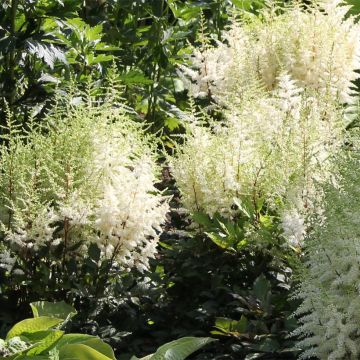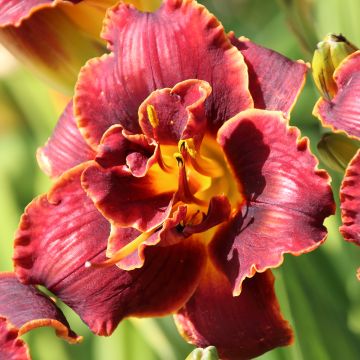

Astilbe arendsii Cappuccino


Astilbe arendsii Cappuccino
Astilbe arendsii Cappuccino
Astilbe x arendsii Cappuccino
Arendsii Astilbe, False Goat's Beard, False Spirea
Special offer!
Receive a €20 voucher for any order over €90 (excluding delivery costs, credit notes, and plastic-free options)!
1- Add your favorite plants to your cart.
2- Once you have reached €90, confirm your order (you can even choose the delivery date!).
3- As soon as your order is shipped, you will receive an email containing your voucher code, valid for 3 months (90 days).
Your voucher is unique and can only be used once, for any order with a minimum value of €20, excluding delivery costs.
Can be combined with other current offers, non-divisible and non-refundable.
Home or relay delivery (depending on size and destination)
Schedule delivery date,
and select date in basket
This plant carries a 12 months recovery warranty
More information
We guarantee the quality of our plants for a full growing cycle, and will replace at our expense any plant that fails to recover under normal climatic and planting conditions.
Would this plant suit my garden?
Set up your Plantfit profile →
Description
Astilbe arendsii 'Cappuccino' is a remarkable variety of astilbe, full of contrast and highly ornamental. Its elegant spring foliage takes on a dark bronze colour, stunning when the first white plumes appear, carried by red stems. It is compact and suitable for border decoration or the middle of small flowerbeds. This perennial plant, which thrives in partial shade and moist soil, appreciates riverbanks and heavy soils that never dry out.
Astilbe 'Cappuccino' is a recent horticultural creation. It is a hardy herbaceous perennial plant from the Saxifragaceae family with a compact habit, reaching a height of approximately 50 to 70 cm when in flower, with a spread of 45 to 60 cm (18 to 24in). It can be planted in flowerbeds, surrounded by shade-loving companions such as ferns and hostas. This rhizomatous plant is deciduous, with foliage emerging in spring and drying up in autumn. 'Cappuccino' astilbe forms an upright clump, composed of stems covered with compound, deeply cut, toothed leaves. The colour of the leaves in spring is a nearly black bronze. After flowering, the foliage turns dark green but retains a rich colour. The flowering occurs in June and July in the form of feathery, delicate inflorescences composed of numerous small flowers that start off very pale greenish-yellow and gradually turn almost pure white when fully open.
Astilbes bring life to shaded paths or the edges of ponds, first with their distinguished foliage, then their elegant and contrasting flowering. In flowerbeds and borders, 'Cappuccino' pairs well with hostas, ferns, solomon's seals, corydalis, and tiarellas. This variety tolerates dense shade. At the end of the season, let the flowers dry in place or remove some spikes to complete a large dried bouquet. The flowers are beautiful in floral compositions and dried bouquets.
Report an error about the product description
Astilbe arendsii Cappuccino in pictures




Flowering
Foliage
Plant habit
Botanical data
Astilbe
x arendsii
Cappuccino
Saxifragaceae
Arendsii Astilbe, False Goat's Beard, False Spirea
Cultivar or hybrid
Other Astilbe - False Goatsbeard
View all →Planting and care
Astilbe thrives in partial shade in rich, moist soils, even marshy and waterlogged in summer. You can plant it in gentle sunlight, but avoid the scorching sun. Plant it in spring or autumn in soil rich in organic matter and make sure it never lacks water from spring until the end of summer. Avoid excessively chalky soils.
To plant, work your well soil over a 20 cm (8in) area and place a base fertiliser at the bottom of the planting hole. Remove your plant from its pot and position, covering the top of the root ball with 3 cm (1in) of soil. Then refill and water copiously to eliminate air pockets. In dry weather, water regularly for a few weeks to aid rooting. Astilbe requires very little maintenance, just keep the soil moist and add compost and fertilizer in spring. In winter the flowers and young foliage can be damaged by spring frosts. Cut the faded flower stems to encourage the foliage. In November, trim the plants to around 10 cm (4in). Avoid digging near these plants, as the rhizomes develop near the surface. These plants are resistant to diseases and rarely attacked by insects. Unattractive to slugs, they can be susceptible to powdery mildew and spots caused by various fungal diseases.
Planting period
Intended location
Care
This item has not been reviewed yet - be the first to leave a review about it.
Similar products
Haven't found what you were looking for?
Hardiness is the lowest winter temperature a plant can endure without suffering serious damage or even dying. However, hardiness is affected by location (a sheltered area, such as a patio), protection (winter cover) and soil type (hardiness is improved by well-drained soil).

Photo Sharing Terms & Conditions
In order to encourage gardeners to interact and share their experiences, Promesse de fleurs offers various media enabling content to be uploaded onto its Site - in particular via the ‘Photo sharing’ module.
The User agrees to refrain from:
- Posting any content that is illegal, prejudicial, insulting, racist, inciteful to hatred, revisionist, contrary to public decency, that infringes on privacy or on the privacy rights of third parties, in particular the publicity rights of persons and goods, intellectual property rights, or the right to privacy.
- Submitting content on behalf of a third party;
- Impersonate the identity of a third party and/or publish any personal information about a third party;
In general, the User undertakes to refrain from any unethical behaviour.
All Content (in particular text, comments, files, images, photos, videos, creative works, etc.), which may be subject to property or intellectual property rights, image or other private rights, shall remain the property of the User, subject to the limited rights granted by the terms of the licence granted by Promesse de fleurs as stated below. Users are at liberty to publish or not to publish such Content on the Site, notably via the ‘Photo Sharing’ facility, and accept that this Content shall be made public and freely accessible, notably on the Internet.
Users further acknowledge, undertake to have ,and guarantee that they hold all necessary rights and permissions to publish such material on the Site, in particular with regard to the legislation in force pertaining to any privacy, property, intellectual property, image, or contractual rights, or rights of any other nature. By publishing such Content on the Site, Users acknowledge accepting full liability as publishers of the Content within the meaning of the law, and grant Promesse de fleurs, free of charge, an inclusive, worldwide licence for the said Content for the entire duration of its publication, including all reproduction, representation, up/downloading, displaying, performing, transmission, and storage rights.
Users also grant permission for their name to be linked to the Content and accept that this link may not always be made available.
By engaging in posting material, Users consent to their Content becoming automatically accessible on the Internet, in particular on other sites and/or blogs and/or web pages of the Promesse de fleurs site, including in particular social pages and the Promesse de fleurs catalogue.
Users may secure the removal of entrusted content free of charge by issuing a simple request via our contact form.
The flowering period indicated on our website applies to countries and regions located in USDA zone 8 (France, the United Kingdom, Ireland, the Netherlands, etc.)
It will vary according to where you live:
- In zones 9 to 10 (Italy, Spain, Greece, etc.), flowering will occur about 2 to 4 weeks earlier.
- In zones 6 to 7 (Germany, Poland, Slovenia, and lower mountainous regions), flowering will be delayed by 2 to 3 weeks.
- In zone 5 (Central Europe, Scandinavia), blooming will be delayed by 3 to 5 weeks.
In temperate climates, pruning of spring-flowering shrubs (forsythia, spireas, etc.) should be done just after flowering.
Pruning of summer-flowering shrubs (Indian Lilac, Perovskia, etc.) can be done in winter or spring.
In cold regions as well as with frost-sensitive plants, avoid pruning too early when severe frosts may still occur.
The planting period indicated on our website applies to countries and regions located in USDA zone 8 (France, United Kingdom, Ireland, Netherlands).
It will vary according to where you live:
- In Mediterranean zones (Marseille, Madrid, Milan, etc.), autumn and winter are the best planting periods.
- In continental zones (Strasbourg, Munich, Vienna, etc.), delay planting by 2 to 3 weeks in spring and bring it forward by 2 to 4 weeks in autumn.
- In mountainous regions (the Alps, Pyrenees, Carpathians, etc.), it is best to plant in late spring (May-June) or late summer (August-September).
The harvesting period indicated on our website applies to countries and regions in USDA zone 8 (France, England, Ireland, the Netherlands).
In colder areas (Scandinavia, Poland, Austria...) fruit and vegetable harvests are likely to be delayed by 3-4 weeks.
In warmer areas (Italy, Spain, Greece, etc.), harvesting will probably take place earlier, depending on weather conditions.
The sowing periods indicated on our website apply to countries and regions within USDA Zone 8 (France, UK, Ireland, Netherlands).
In colder areas (Scandinavia, Poland, Austria...), delay any outdoor sowing by 3-4 weeks, or sow under glass.
In warmer climes (Italy, Spain, Greece, etc.), bring outdoor sowing forward by a few weeks.



















































